 |
Exploring the Horizons of
Mycophagy
on the Olympic Peninsula of Washington
Page 1
|
|
Mycophagy --The eating of fungi; esp. of those species
usually neglected or avoided.
Tooth Jelly: |
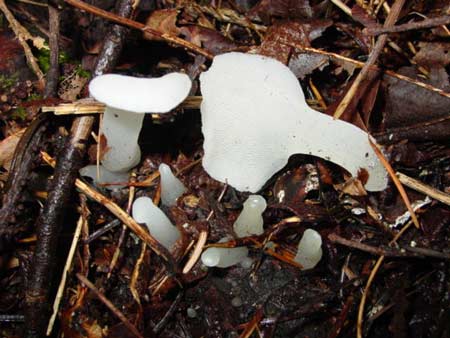 |
| |
|
|
| |
Mushroom Mystique
As I sit down to compose this article, a new generation of
fungus gnats emerges and takes flight in my cabin, flittering
around my desk lamp like myco-foragers combing a promising new
patch of wet, lush ground. A seething conglobate of their future
cohorts writhe across my desk, desperate to return to the wild.
I oblige them via an index card. Fungi of various shapes and
sizes, and in various stages of health and decay (hence the
insects), wait to be identified while scattered upon sheets of
white printer paper. Having spent the last three years in the
San Francisco Bay region, and now on the Olympic Peninsula of
Washington, has provided me with the glorious opportunity to
stalk the wild mushroom in some very mycologically-diverse
regions of North America. As I forage for edible or otherwise
useful botanicals, insects and geologic gifts, it is rare to not
encounter the ubiquitous Yellow-Stemmed Mycena (Mycena
epipterygia), the omnipresent, gelatinous Poor-Man’s Gumdrop (Guepiniopsis
alpinus) or the abundant troops of the delightfully slimy Oregon
Gomphidius (Gomphidius oregonensis). During the cooler, rainy
winters here the mushroom can nearly always provide a sizeable
and reliable meal. It would be a shame to ignore such a feast
for the eyes and stomach for the wont of a little knowledge of
how to incorporate these organisms into one’s everyday foraging
habits. You may even be rewarded by a hidden population of
fungus gnat larvae that gracefully float to the top of any soup
that your mushrooms may have become part of (delicious!). Why
not learn about our fungal friends and partake of this woodland
bounty?
Admirable Bolete: |
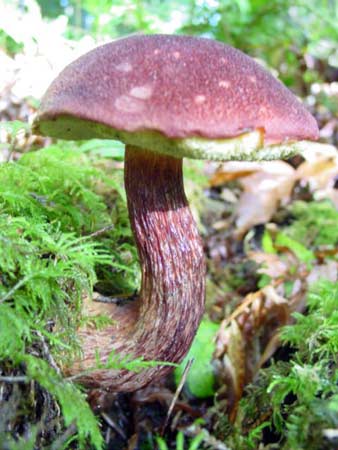 |
| |
|
I decided to write this article in
response to the richly diverse reactions I get from passersby
while I hunt mushrooms. Basket and camera in tow, up in a tree
or face-first in the dirt, whatever breed of spectacle I present
inevitably elicits the fear, the fantasy or the fascination the
general public holds for Kingdom Fungi. Here is a sample of
comments people have offered me in passing:
- from a young man: “If you boil the
mushroom with a piece of silver, the mushroom will be edible if
the water doesn’t turn black.”—Does this mean that deliquescing
Coprinus sp. (Inky Caps) are poisonous?
- from a young man: “I only eat mushrooms that don’t taste
sour.”—unfortunately that closes the door on a lot of perfectly
edible Boletes, and welcomes a host of deadly Amanitas!
- from a middle-aged couple: “They’re safe if they aren’t
bitter, right?”—Amanita phalloides (Death Cap) and A. ocreata
(Destroying Angel) aren’t the least bit bitter...
- from an elderly couple: “You remind me of when we were
children, picking mushrooms with our grandparents in France.
That was during the war, you know, and people got sick trying to
eat all sorts of mushrooms when the food supply was down. But
Grandfather knew what he was doing, and mushrooms got us
through.”—I love these kinds of interactions.
- from a group of young men: “Hey, man...have you found any real
good ones? You know, the kind that stain blue?”—I get tired of
these interactions.
- from a middle-aged woman: “I never touch those things. They
can kill you! One of my friends ended up in the hospital after
touching one that grew in the woods!”—I’ve never encountered a
mushroom that bites...
- from a group of pre-schoolers: “Awwww, they’re so cute! Are
they alive?”—That’s why I’m a naturalist...
Black Morel: |
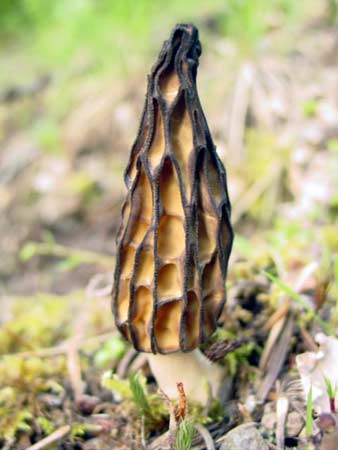 |
| |
| In light of these interactions, and many more, I thought it
was time for me to educate myself on the various positive
aspects of fungi, especially those related to edibility, and
relate my findings and personal experiences to other mycophiles.
I write this article from the perspective of a person who get
bombarded with the anxiety and fear from students of all ages
regarding fungi. I am also a student of all things Stone-Age,
including paleo-nutrition and foraging dynamics: I have eaten
nearly 300 species of fungi and value the consumption of wild
mushrooms as a way to understand and directly interact with my
environment. The pictures that accompany this article present
some of the lesser-eaten species that I am particularly fond of.
Chocolate Tube
Slime: |
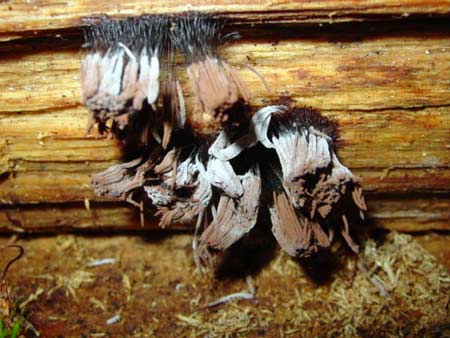 |
| |
|
The Joy of Mushrooms
Would it surprise you to hear that some evolutionary biologists
consider fungi to be more closely related to Kingdom Animalia
than Plantae? It appears that humans and fungi had a common
ancestor around 460 million years ago. To wit: Mushrooms can
store energy in the form of glycogen; some mushrooms contain
vitamin B12 (very important for vegetarians); and mushrooms
produce chitin, the substance that forms the carapaces of
crustacea. While animals share these characteristics, there may
be no plants that can perform such feats. A curious note: at
least some slime molds’ (Myxomycetes) spores, when released and
having alighted upon a suitable substrate, transform into an
animalcule equipped with flagellae (similar to sperm). It then
has the animal-like capability of swimming to a desirable
location and again transmuting to “a living envelope of cellular
ooze."
If this isn’t enough to endear you to rush outside and embrace
the nearest fleshy fungal fruitification that adorns your
compost heap, rotting outbuilding or the canes of your favorite
armed berry-plant, then consider their proposed nutritional
benefits. Although it is not within the scope of this article to
fastidiously and independently verify each of the following
claims (see References at the end of this article for more
information), read on:
- The common grocer’s brown button mushroom (Agaricus
bisporus) and its slightly older self, the portabella, which
is a cultivated form of the wild field mushroom (Agaricus
campestris), is nearly equivalent to milk regarding amino
acid content.
- Some mushrooms add fiber, niacin, riboflavin, vitamin
B12, and all of the amino acids—complete protein.
- "The vitamin content of mushrooms resembles that of
meat."
- "Scientists have only recently confirmed what ancient
cultures have known for centuries: mushrooms have within
them some of the most potent medicines found in nature. Long
viewed as tonics, we now know that their cellular
constituents can profoundly improve the quality of human
health. Differing from most pharmaceuticals, these healing
agents have extraordinarily low toxicity, even at high
doses."
- Many polypore species, and some gilled mushrooms are
great sources of anti-tumor, anti-viral and anti-bacterial
metabolites. The cosmopolitan Turkey Tail fungus has been
shown to impede the growth of Candida infections.
- A lot of mushrooms contain MSG, which can magnify the
flavor of other foods. Some of you may recall the purported
link between MSG and certain illnesses, but Professor
William Wood of Humbolt State University explains, “This is
the same chemical once believed to be responsible for the
'Chinese Restaurant Syndrome.' It is now known that
histamines in soy sauce are the real culprit."
- Since many mushrooms contain chitin and its more easily
digested derivative, chitosan, their consumption can elicit
such benefits as: enhanced tissue repair, quicker burn and
wound healing, increased resistance against some blood and
skin pathogens, among others. Dr. Goodman also notes that,
"Mexicans have used mushrooms with their chitosanaceous cell
walls to accelerate laceration wound healing."
|
| "There is but one way by which to determine the edibility of a
species. If it looks and smells inviting, and its species cannot
be determined, taste a very small piece. Do not swallow it. Note
the effect on the tongue and mouth. But many species, delicious
when cooked, are not inviting raw. Cook a small piece; do not
season it. Taste again; if agreeable eat it (unless it is an
Amanita). After several hours, no unpleasant effect arising,
cook a larger piece, and increase the quantity until fully
satisfied as to its qualities. Never vary from this system, no
matter how much tempted. No possible danger can arise from
adhering firmly to it." Deer Truffle: |
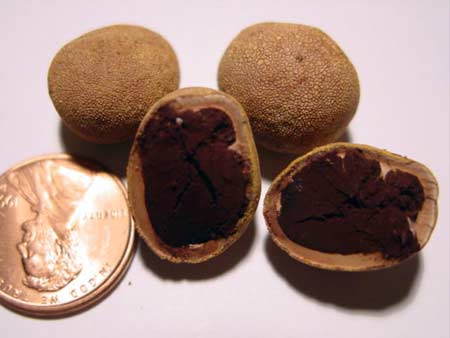 |
| |
Those Before Me
Although I disagree with that last sentence, I am inspired by
the sheer volume of Captain Charles McIlvaine’s mycophagic
experimentation (nearly 800 species!), especially when
considering the relative paucity of information back then
regarding the possible dangers of this undertaking. The modern
“toadstool tester” can now thankfully peruse the pages of such
books as David Arora’s Mushrooms Demystified and note the
various accumulative (Hygrocybe punicea concentrates cadmium
within its tissues), synergistic (Coprinus and alcohol shouldn’t
be mixed), or latent (serious symptoms of Cortinarius poisoning
can delay up to 20 days) dangers that may have been little-known
a century ago. But perhaps there are still those of us who,
while deeply respecting the powers of Kingdom Fungi, simply wish
to replenish a body of knowledge lost in part by the past
ravages of cultural displacement.
Some assert that experimenting with mushrooms is unnecessary,
for, “our ancestors have already provided for us, through trial
and error, a comprehensive list” from which we can glean. While
I agree that we should take the time to learn about wild
organisms before stuffing them into our mouths, the available
body of knowledge is far from complete, if not unavailable. I am
hard-pressed to find such information on mushrooms eaten by past
tribes in the whole of North America. I feel a certain
excitement when, upon looking up the edibility of a freshly
keyed-out specimen, I’m offered the succinct disappointment,
“Unknown,” which is oft-tempered by that fickle admonition, “Do
not experiment.” Woe cometh the day when I do not heed such
judgment as a charge to step forth and claim my right—No, my
privilege!--to push the horizons of current wisdom surrounding
the species at hand (and soon at mouth!). The miraculous gifts
inherent within dozens, if not hundreds, of otherwise edible (in
my experience) and quite common—to the experienced eye--species
are being inadvertently snubbed by condemnations such as: too
slimy; rank odor; acrid or bitter taste; not recommended; not
edible due to its resemblance to species of unknown edibility;
too tough or gelatinous in texture; of no consequence due to
small size. Many of these misconceptions can be remedied thusly:
pounding of species with tough flesh to render them more
palatable; cooking and pickling can dispel many acrid or bitter
tastes, especially within the genera of Lactarius, Agaricus and
Russula; infusing tough, woody species with hot water in order
to ingest nutrients, essences and flavors as a tea; be sure of
your identification; and, lastly, my favorite—expanding
acceptance of diverse foodstuffs through the purging of food
prejudices.Red-Belted Conk: |
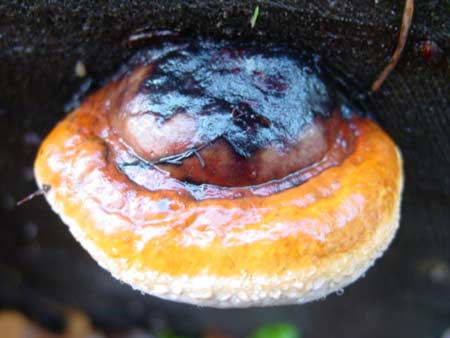 |
| |
|
On to Page 2... |
| |
|
|
|
 |
 |
 |



